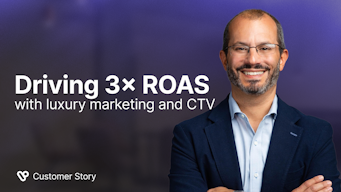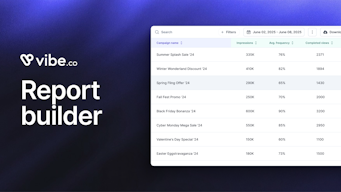How to Grow your Law Firm Advertising Impact
Welcome to 2025, where SEO competition is fiercer than it’s ever been, new privacy regulations have led to devastating mobile signal loss, and unprecedented digital consumption fragmentation is wreaking havoc on even the most robust law firm marketing strategies. Meanwhile, law firm marketing is increasingly competitive. In public-facing areas especially, like personal injury, family law, or mass tort, advertisers need to be strategic and innovative in their marketing efforts to stay ahead of the competition.
It can be difficult to understand where and how to innovate in a rapidly shifting digital landscape, so we are sharing the ultimate marketing round-up for law firms and attorneys: a list of high-impact strategies that have helped thousands of law firms increase their client base and revenue.
Regardless of your firm’s size, area of expertise, or location, your 2025 law firm advertising strategy needs to be laser-focused on 3 key strategic goals:
- Brand Trust
- Storytelling and Recall
- Trackable Performance
If you're a law firm or an attorney looking to take your marketing efforts to the next level, read on to learn how Search Ads, OOH advertising, and Streaming TV can transform your lead generation processes in just a few easy steps.
Not your mother’s Search Engine Marketing
93% of all law firm-related searches are made within a specific geographic location, which makes site-specific SEO especially important; but marketers beware! SEO prices and performances are not what they used to be, especially in a highly competitive industry like legal marketing. Gone are the days of affordable, discoverable Google My Business profiles. Today, impactful search engine listings need a strategy behind them.
Here are the top 5 ways to ensure your SEO strategy drives results in 2025.
- Test early, and test often. Research keywords, description relevance, and brand positioning on the front end, but don’t be afraid to pivot if your first Search Ads campaign doesn’t yield the results you were expecting right away. That’s how we learn! Make sure to set up your search engine dashboards in a way that will allow you to monitor results at a glance, and shift strategy when needed. Remember, your main goal when developing a Search Engine Marketing strategy is relevance. Use that as the prism through which you evaluate your strategy if it doesn’t yield results immediately.
- Use a mobile-friendly landing page design. About 51% of all web traffic now originates from mobile devices with smaller screens. Make sure you optimize all of your landing pages to improve the overall browsing experience of your law firm’s website, keep prospects on your page longer, and move your page up on all search engines.
- Leverage ad extensions in your listing. Did you know that the larger your ads the more likely users are to click on them? Studies have shown that users are more likely to click on larger ads that appear on their search result pages. Ad extensions can help you enlarge your ads by including more of your business information in them. In your ad, you should also include a call and sitelink extension for extra relevance and actionability.
- Use as many original images and alt text as possible in your web copy as possible to reinforce your standing as an original (and relevant!) content creator for search engine crawlers.
- Develop a coherent omni-channel strategy. Some old marketing idioms stand the test of time, and the famous Rule of Seven, which suggests that prospects need to hear a message a minimum of seven times to remember it, holds especially true today. Your SEM efforts will only yield the results you are looking for as part of a larger customer engagement strategy across channels and devices. Read on for ways to develop more client touch points.
Doh! I should have tried DOOH!
Few industries have embraced billboard advertising (also known as OOH advertising) as enthusiastically as the legal sector, with varying levels of success. Some of the main issues plaguing the Out Of Home advertising industry are its archaic onboarding format, which often still requires marketers to select ad locations from unwieldy maps and very little flexibility once the creative is up and running:
- The media used in traditional OOH advertising tends to be static, so marketers need to take into account indeterminate variables to see a return on investment, including the physical location of the display, its design, and the amount of time that the consumer is exposed to it.
- Production fees associated with updating or changing printed ads can prove expensive.
- Billboard material can fade, peel or weather, leaving your firm’s brand image tarnished.
- Wait time when you want to change ads or messaging can be extremely protracted.
That’s why our recommendation to law firms interested in keeping their ads on billboards is to switch to Digital Out Of Home (DOOH) providers or self-serve hybrids like Blip which allow you to optimize, target, and track your campaign KPIs much more efficiently. More importantly, purchasing advertising space on billboards and other Out of Home inventory can be a cumbersome, time-consuming process, with middlemen negotiating prices with ad space owners, which can increase cost many times over.
Control your cost and scale your campaign fast with programmatic digital billboard campaigns that can deliver relevant ads to targeted audiences at the perfect moment when they walk or travel past the digital signage, and respond coherently to your ads running on other, complementary channels.
Again, law firm marketers will need to develop this type of campaign in conjunction with other impactful channels like streaming and digital. The connection between out-of-home and digital media is undeniable, as prospects and business stakeholders are constantly connected through our devices; exposure to OOH can boost engagement with those devices and other media.
The Verdict is In: Cable is Out
In the last 2 years, Connected Television viewership has grown to 4 times what it was before the pandemic and shows no sign of slowing down. In fact, 94% of all US households with television now own at least one connected television device and spend twice as much time watching programs on a connected device than on traditional television. As of 2025, 70 million US viewers have “cut the cord” and left cable for CTV. That’s a lot of time and attention your ads are probably not getting.
Even more important than the volume of potential new viewers, however, is the unprecedented ability marketers now have to target viewers who fit the profile of qualified leads. Because streamed television programs are delivered over the internet, connected television advertising platforms can use IP addresses to target (and retarget) viewers by geo-location, demographic, household income, interest, and more.
Targeting clients on streamed content also means advertisers can reach audiences on different device types - mobile, tablet, and television screens, so you’re not missing folks watching the news on their phone during their morning commute, or snuggling up to their tablets at night.
Is this starting to sound more like digital advertising on social media or Google Ads? That’s because the functionalities are the same:
- Low cost of entry
- Pacing control
- Real-time reporting
- Simple platform interface
- Targeted audiences
- No contracts
But you also get the benefits of television advertising:
- Non-skippable ads
- 97% view-through rate
- Unparalleled storytelling
- Highly engaged audience
- Brand building next to quality content
When someone needs legal help in today’s world, they will look it up online, not call a number from a billboard or radio jingle they memorized through sheer repetition. That’s why brand storytelling and recall should be at the very top of your campaign goals. There are a few ways to measure that.
Connected Television advertising has a new set of metrics to follow, as it adapts to new viewer behaviors. It doesn’t rely on vague Nielsen report numbers for average impressions by DMA (Designated Marketing Area) like traditional television advertising does, but it doesn’t follow typical display advertising metrics either.
Here’s what to look for:
- Reach (the number of users that viewed your ad) and frequency (how many times users saw your ad)
- CPCV (Cost Per Completed View)
- VCR (Video Completion Rate)
- CPM (Cost per 1,000 impressions)
- Impressions by geo, state, county & zip
- Views by device
- Increase in branded search traffic to your website
- Call tracking activity
- Increase in total leads generated
Streaming TV Advertising Best Practices
Wondering how to get the most out of your law firm’s ad on a new medium? Here’s a cheat sheet. It can be our little secret.
- Before anything else, identify the goal of your campaign: are you looking for brand awareness or programmatic performance? This decision will affect creative, strategy, and KPIs, so consider it carefully.
- Avoid the temptation to get too granular in targeting so that your reach can stay where you need it. If you want to target several segment sets, consider dividing your campaign into different strategies.
- Test often. One of the most revolutionary changes CTV has brought to the TV advertising landscape is real-time reporting. This affords users unprecedented flexibility in budget, creative, and targeting. Make the most of it!
- We recommend Automatic Bidding in order to get the most out of your budget.
- Be concise and to the point - especially for performance ads.
- Don’t ignore audio. If you are used to social ads, you already know how to create impactful graphics, but sound is an intrinsic part of TV advertising - make the most of it!
- People want to watch people. Include people and faces in your creative if at all possible.
- Keep your branding - URL/logo/brand name - on the screen at all times.
- Use a strong CTA at the end of the ad, preferably with a voice over restating it.
- Stuck on creative? We have partners to help you! Simply contact support.
Now is a good time to get started with a powerful marketing medium that your competition may not have started using yet.


